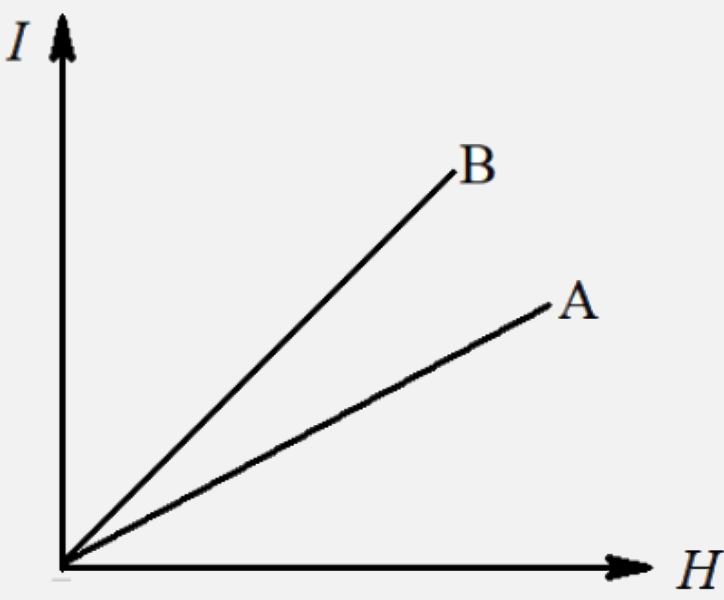In which type of material the magnetic susceptibility does not depend on temperature?
Diamagnetic
Paramagnetic
Ferromagnetic
Ferrite
The correct Answer is:A
Step-by-Step Solution:
1. Understanding Magnetic Susceptibility:
- Magnetic susceptibility (Xm) is a measure of how easily a material can be magnetized. It indicates the degree of magnetization of a material in response to an applied magnetic field.
2. Types of Magnetic Materials:
- There are different types of magnetic materials:
- Diamagnetic Materials: These materials have a very weak and negative susceptibility to magnetic fields. They do not retain magnetic properties when the external field is removed.
- Paramagnetic Materials: These materials have a positive susceptibility and are weakly attracted by a magnetic field. Their magnetic properties depend on temperature.
- Ferromagnetic Materials: These materials have a strong positive susceptibility and can retain magnetization. Their magnetic properties also depend on temperature.
3. Effect of Temperature on Magnetic Susceptibility:
- For paramagnetic and ferromagnetic materials, the magnetic susceptibility changes with temperature. As temperature increases, the thermal agitation disrupts the alignment of magnetic moments, leading to a decrease in susceptibility.
- In contrast, diamagnetic materials do not exhibit a change in magnetic susceptibility with temperature. Their magnetic properties remain constant regardless of temperature changes.
4. Conclusion:
- Therefore, the type of material in which the magnetic susceptibility does not depend on temperature is diamagnetic material.
Final Answer:
- Diamagnetic material is the type of material in which the magnetic susceptibility does not depend on temperature.
---
- Magnetic susceptibility (Xm) is a measure of how easily a material can be magnetized. It indicates the degree of magnetization of a material in response to an applied magnetic field.
- There are different types of magnetic materials:
- Diamagnetic Materials: These materials have a very weak and negative susceptibility to magnetic fields. They do not retain magnetic properties when the external field is removed.
- Paramagnetic Materials: These materials have a positive susceptibility and are weakly attracted by a magnetic field. Their magnetic properties depend on temperature.
- Ferromagnetic Materials: These materials have a strong positive susceptibility and can retain magnetization. Their magnetic properties also depend on temperature.
- For paramagnetic and ferromagnetic materials, the magnetic susceptibility changes with temperature. As temperature increases, the thermal agitation disrupts the alignment of magnetic moments, leading to a decrease in susceptibility.
- In contrast, diamagnetic materials do not exhibit a change in magnetic susceptibility with temperature. Their magnetic properties remain constant regardless of temperature changes.
- Therefore, the type of material in which the magnetic susceptibility does not depend on temperature is diamagnetic material.
- Diamagnetic material is the type of material in which the magnetic susceptibility does not depend on temperature.
Similar Questions
Knowledge Check
Point out the best representation of relation between magnetic susceptibility (Chi) and temperature (T) for a paramagnetic material
A B
B C
C D
D
Magnetic susceptibility of the following type does not depend upon temperature
View SolutionThe following figure shows the variation of intensity of magnetisation I versus the applied magnetic field intensity H, for two magnetic materials A and B

Which of the material have a larger susceptibility for a given field at constant temperature?
View SolutionThe correct graph which shows the variation of paramagnetic susceptibility S with temperature T is
View SolutionFor a paramagnetic materical, the dependence of the magnetic susceptibility χ on the absolute tempreture T is given by
View SolutionHow does the magnetic susceptibility of a paramagnetic material change with temperature?
View SolutionWhich materials have negative value of magnetic susceptibility?
View SolutionThe electric susceptibility of water vapour is strongly dependent on temperature:
Temperature t,∘C120150180210Pressure p,mmHg565609653698
Electric susceptibility χe4.00×10−3,3.72×10−3,3.49×10−33.29×10−3
Plot a graph and find the temperature dependence of the electric susceptibility. Calculate the dipole moment of a molecule of water.
View Solution
